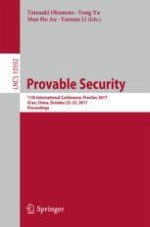2017 | OriginalPaper | Buchkapitel
Homomorphic Secret Sharing from Paillier Encryption
verfasst von : Nelly Fazio, Rosario Gennaro, Tahereh Jafarikhah, William E. Skeith III
Erschienen in: Provable Security
Aktivieren Sie unsere intelligente Suche, um passende Fachinhalte oder Patente zu finden.
Wählen Sie Textabschnitte aus um mit Künstlicher Intelligenz passenden Patente zu finden. powered by
Markieren Sie Textabschnitte, um KI-gestützt weitere passende Inhalte zu finden. powered by
